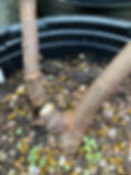Revive an Unhealthy Fig Tree
- Ross the Fig BOSS
- Oct 7, 2023
- 6 min read
Updated: Jul 2, 2024
Check out the companion video to this article below:
Want to revive your unhealthy fig tree? You're in the right place. I'm Ross the Fig Boss, and I've been passionate about fig trees since 2014. I've killed more fig trees than most people have seen, but I've learned valuable lessons from my mistakes.
I've also discovered a trick most growers don't know about to revive unhealthy fig trees and set them up for long-term success. In this article, I'll explain all of the ways to bring your fig tree back to life.
A healthy fig tree not only produces more fruit but also faces fewer problems. The link between tree health and fruit production is clear.
For more fig-related content like this, subscribe to the Fig Boss monthly newsletter at the top of the page.
First, we need to focus on giving your fig tree what it needs.
Caring for Fig Trees
Sunlight:
Fig trees need a warm, sunny spot with lots of direct sunlight. If your tree isn't happy, putting it in the shade may help temporarily, but if it's stable, sunlight is its best medicine.
Warmth from sunlight helps your tree maintain a proper metabolism. Just like animals, plants have metabolisms too. In cooler spring and fall temperatures, fig trees can't absorb water and nutrients as efficiently as they do in the summer.
Water:
Improper watering practices might just be the number 1 reason why your fig tree is unhealthy.
When soil is waterlogged, it lacks air, causing anaerobic conditions that promote root rot, a fungus that rots fig tree roots. Figs are prone to root rot because their roots are thin and fibrous.
If your tree is small and fragile, let the soil dry out between waterings. This dry period helps restore the balance of oxygen and microbes in the soil, reducing root rot.
Related: Fig Tree Watering | How Much Water, When to Water & Why Excess Water Leads to Watered-Down Figs!
Fertilizing:
Figs are heavy feeders and if they're unhealthy, your tree can't uptake the nutrients it needs. Often, the nutrients are already in the soil, but the tree can't absorb them due to cool soil or too much water.
Instead of adding more water and fertilizer, use a bit of slow-release fertilizer. Too much food can make things worse. Slow-release fertilizer provides the right amount of nutrients with each watering, giving your tree a gentle dose of food.
Now that we've got the basics out of the way, it's important to understand a virus that affects all fig trees and how to fix it called Fig Mosaic Virus. The virus causes symptoms that make it harder for affected trees to photosynthesize and gather energy, potentially leading to a long-term weakening of your tree.
Identifying Fig Mosaic Virus
This virus causes mottled, discolored leaves, deformed growth, and reduced fruit quality and yield.
Mosaic Pattern: Irregular patches of, yellow, light green, and dark green on the leaves.
Strange Growth: Distorted, deformed, or stunted leaves and branches growing in odd directions. The fruits are directly unaffected by the virus.
Here's where the trick comes in to fix your fig tree's health. It's a type of pruning called rejuvenation pruning.
Improving Your Fig Tree's Health
Starting a fig tree off right is key to its long-term health and one common mistake can affect a fig tree for its entire life if not fixed early.
When growing new fig trees from cuttings, many turn out different from the original tree. This happens because each bud on a fig tree is unique. They have different levels of nutrients and hormones and can vary in how much they are affected by fig mosaic virus (FMV).
Many growers, including myself, have noticed that fig trees from cuttings often sprout a strong shoot and grow well. However, some produce a weaker shoot or only grow one weak shoot with poor growth and fruit production. This is likely due to different levels of FMV in various parts of the fig tree.
To fix this, I suggest rejuvenation pruning, which means cutting away weak growth and bad buds to help the tree grow better.
You can find a full guide to rejuvenation pruning, here.
To ensure a healthy tree, I let each tree grow naturally in its early years. While some growers let only one shoot grow from a cutting, I let multiple shoots grow. This allows me to choose the healthiest and strongest shoot, helping the tree thrive in the long run.
Identifying an Unhealthy Fig Tree
For the tree's long-term health, it's common sense to eliminate the unhealthy growth. However, the challenge many face is distinguishing between healthy and unhealthy growth.
If you're propagating a fig from a cutting, one definitive indication is the vigor of the shoot's growth. If one shoot is growing more robustly and fruiting more efficiently than the other, that's your clue.
Another way to gauge is by the fruit count and the growth pattern. If a particular shoot has sparse fruits and exhibits an unusual growth pattern, like closely spaced nodes or leaves, it's likely not the healthiest.
A clear manifestation of the fig mosaic virus is evident on the leaves, which might show severe spotting, mottling, or deformities.
All these signs hint at compromised tree health.
Photos comparing unhealthy wood to healthy wood:
Does the Virus Go Away on Its Own?
Some growers believe the virus will fade over time, but this isn't always true. If your tree's structure is weak due to the virus, overcoming it can be difficult and never happen.
In my experience growing fig trees, rejuvenation pruning is crucial for long-term health. I assess each tree's health and prune hard if needed. If one prune doesn't work, I try again the next year.
Sometimes it takes two or three prunings for a fig tree to recover. Patience pays off, and eventually, the pruning yields good results.
An example of a mild case of FMV:

One Warning
If your tree is young, not well established, and is growing poorly due to soil health and improper watering practices, I would not perform this technique until these requirements are met first. Hard pruning a weak tree could result in the death of your fig tree.
Does This Apply to Fig Trees Planted in the Ground?
This logic isn't confined to container-grown fig trees. Even those planted in the ground, which more frequently send up numerous shoots from the soil, follow the same principle. Always opt for the healthiest shoots and discard the rest. This ensures a faster-growing, healthier fig tree in the long run.
When planting fig trees, I always prune them hard before or after planting. That way I can be confident new and healthy growth can help establish my planting sooner.

What if My Tree is Older? Can I Fix it?
If you find yourself with an ailing tree, a drastic prune might be the rescue.
To demonstrate, using my pruning shears, I'll cut make as low as possible right at the base, almost to the roots, to remove the entire unhealthy branch. Prune to wood that you believe is healthy.
Remember to leave some viable nodes above the soil. The objective is for new healthy shoots to grow from below the soil, but you can't always be confident viable nodes exist below the soil.

















